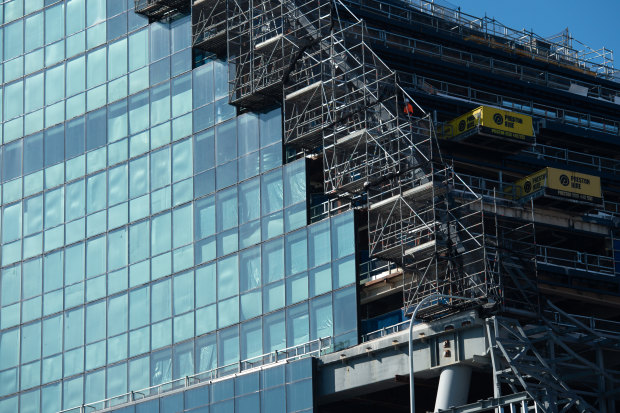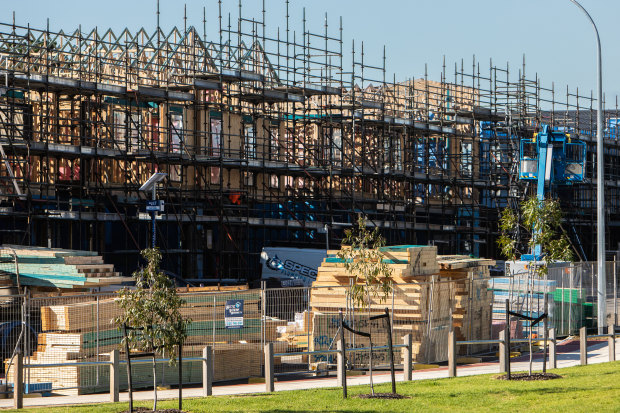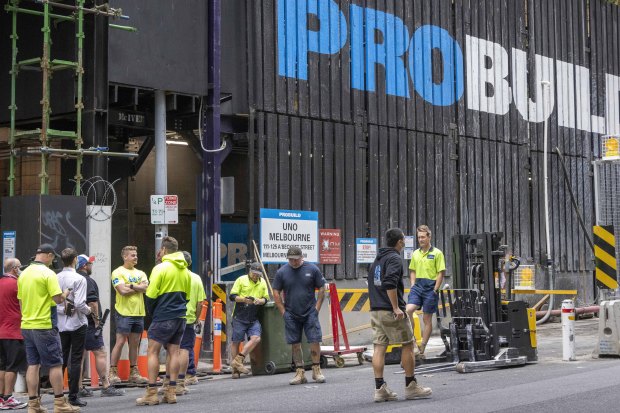This was published 3 years ago
‘On a tightrope’: Construction industry creaking under pressure
By Sarah Danckert and Simon Johanson
If there is one building site in Australia that demonstrates the economic tightrope the construction industry is walking it’s the Ribbon project in Sydney’s Darling Harbour.
Wrapped in glass and jutting out from between two arms of the Western Distributor that snakes through the city’s CBD, the hotel and entertainment precinct development has burned through two builders in just two years.

The Ribbon back in July 2020 seven months after Grocon’s collapse. Work has progressed since then but the collapse of the project’s replacement builder Probuild brought work again to a stop. Credit: Wolter Peeters, Sydney Morning Herald
After the first builder at the site, Melbourne’s Grocon, collapsed in late 2019, fellow Melbourne builder Probuild took over the job only to call in administrators earlier this year as cost pressures across its business began to bite.
In a bright spot of news, The Age and Sydney Morning Herald can reveal that Multiplex has taken over the Ribbon project with work resuming at the site this week, while Probuild’s South African parent is considering a rescue package to resurrect what is left of its business after the sale process.
Despite these reprieves, the industry is teetering towards a crisis and operators across the country are already under stress from increasing steel and timber costs, supply chain delays and labour shortages. There are real fears interest rate rises in the coming year will push more groups over the edge.
Late last month the nation’s largest home builder Metricon held emergency talks with the Victorian and NSW state governments before striking a new funding deal with its shareholders and bankers, as it struggled to contain the losses on contracts it struck with clients before costs on raw materials shot up considerably.
At the same time a major infrastructure rollout is eating up tradespeople and other skilled workers, further pushing up labour costs for residential and commercial builders.
Other home builders and large subcontractor groups are also said to be feeling the pinch. This week, both ANZ chief executive Shayne Elliott and NAB boss Ross McEwan warned there would be more pain in a sector that generates 9 per cent of the country’s gross domestic product, or $360 billion in revenue.
Perth-based housing estate developer Nigel Satterley said the country’s west was suffering acute shortages of truck drivers, machinery operators, plumbers and drainers.
His company, Satterley Property Group, is also confronted with supply constraints in Victoria and Queensland where it also has extensive land developments.

Perth-based Nigel Satterley says the industry can’t digest the sheer volume of work it has been bringing on. Credit: Fairfax
“In Melbourne the contractors are far better resourced than in Perth, although everything is also tight in Melbourne,” he says.
Last year about 34,000 land lots were sold in Melbourne and Geelong’s growth suburbs. “We think the industry can only build about 20,000 a year, so there’s a bit of indigestion to come there,” he says.
Satterley is not alone in sharing concerns about the sector. One senior executive at one of the biggest development groups in the country, who declined to be named for business relationship reasons, believes there will be more pain in the sector.
“We’re seeing the end of a cycle that has been running for 15 years. Now it’s a cleansing and, unfortunately, there will be losers. Things will need to be priced accordingly. Projects will be put into abeyance because the numbers now just don’t stack up.”
Experts are pointing to more pain in the sector as groups reassess project finances as inflationary pressures, supply chain disruptions and labour shortages begin to bite.
“Resourcing challenges, supply challenges, logistics, they’re all real issues. It’s an industry where there’s been a culture of low margins,” says Marc Colella, industry director at global engineering and consultancy firm Aecom.
That means there is no fat in the system when costs start rising and labour markets are stretched, he says.
“It’s certainly putting those larger projects under a significant amount of pressure with the escalation that we’re experiencing across the trades and also across the supply chain.”
Smaller domestic builders with three or four projects, who signed fixed contracts one or two years ago, are most at risk, Colella says.

The building industry is facing challenges with land, labour and materials.Credit: Scott McNaughton
“If you look at the domestic scale, I think the challenges there are even more pronounced because the systems and supply chains are not as advanced.
“I think they’re probably under more threat because their financial backing is limited and they are not as diverse.
Colella says there is less risk for the bigger and more sophisticated national and international contractors because they have more diversity and contingencies, but there is still a lot of pressure.
”While the government is still stimulating the construction market, particularly for infrastructure projects, I don’t see any relief in the immediate future. We are a couple of years away from the industry starting to settle down again,” he says.
The pressure is being felt not just by contractors, it’s spread to all the stakeholders, financiers, designers and engineers.
“The design and construction industry was reliant on the growth of specialist talent and skills through immigration. We are now experiencing a significant skills shortage due to the border closures during the pandemic, in a market that is experiencing historic high infrastructure investment, so in combination with cost escalation and supply chain pressures, it could be considered as a perfect storm,” Colella says.
Ted Fitzgerald, a partner at KordaMentha’s real estate advisory business and an expert in the construction industry, says developers are starting to ask tougher questions of their builders to ensure they are safeguarded against any collapse.

Probuild went under in March with $5 billion in projects on its books.Credit: Wayne Taylor
“Developers are looking for builders with more robust balance sheets and parent company guarantees, so they can be sure that the uncapped liability that the builder signs up to can be delivered upon because when the builder goes into liquidation, the developer has to pick up the pieces in addition to the additional costs,” Fitzgerald says.
At the same time, he says builders are beginning to look up the food chain to developers for support.
“We’re seeing situations in the market where builders are approaching developers and trying to share the burden of these cost increases, but developers are wary of setting a precedent and then not being able to control contagion risk in the industry.
“They’re doing their best to survive the situation and I think the good and well-capitalised builders are sharing in the pain with their subcontractors, but it’s hard when multiple subcontractors have issues and the builder is on a tightrope with the developer on time and cost.
Fitzgerald says there are real economic headwinds facing the industry as well as a structural problem with how the sector operates.
“The structural issues stem from the transfer of risk down to those who can least afford it. That goes from developers transferring risk to head contractors and then head contractors transferring risk down to subcontractors.
“It’s the pushing of the risk down the line to those that can least afford it that creates this brittleness leading to a disproportionate representation of insolvency in the construction sector.”
Keen watchers of the construction sector point to another structural problem that has led to subcontractors, including large subcontractors that bring workers onto projects, being forced to bear the financial stress of an overextended builder.
In 2018, a federal government review of the security of payments laws within the construction industry conducted by former Master Builders Association boss John Murray urged state and federal governments to bring in new laws to protect subcontractors from the financial consequences of a major builder collapse. This is in part driven by laws that allow contractors to shuffle money paid to it for the work of subcontractors throughout its business to fuel other projects or to pay other subcontractors first.
Dave Noonan, the national secretary of the CFMEU’s construction arm and a director at developer CBUS Property Group, says the union supports the recommendations of the Murray Review.
“We support the recommendations of the Murray review process, the legislation should require cascading statutory trusts,” Noonan says. These trusts would ensure that money would be kept aside to pay subcontractors for the work that they do.
“The fundamental question here is whether principal contractors and builders should be able to use other people’s money – in other words, the subcontractors’ money – for any purpose they want and we think the current practice is not working and that legislation is required to protect the interests of subcontractors and workers.”
Yet change like this takes time and with the crisis raging in the industry, market watchers believe any changes - structural, legislative or otherwise - will come too late to save some operators.
The Business Briefing newsletter delivers major stories, exclusive coverage and expert opinion. Sign up to get it every weekday morning.